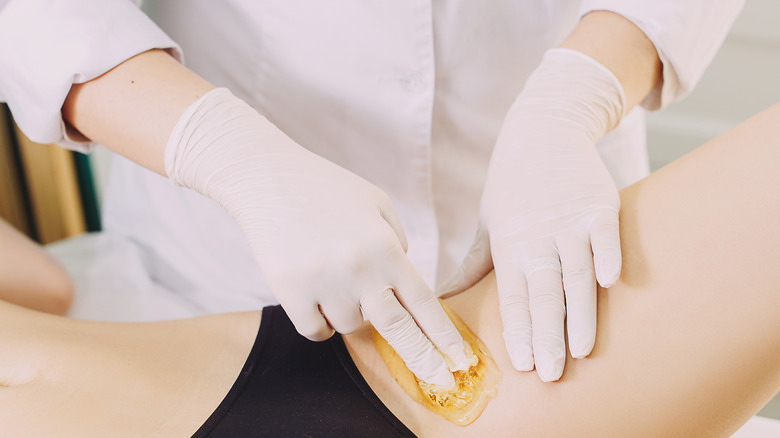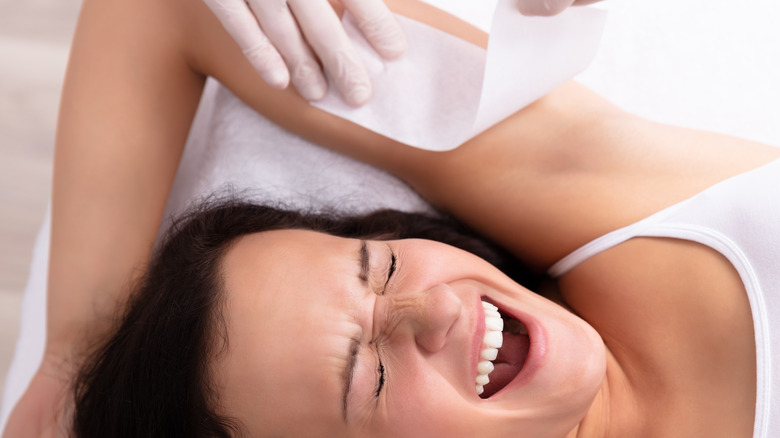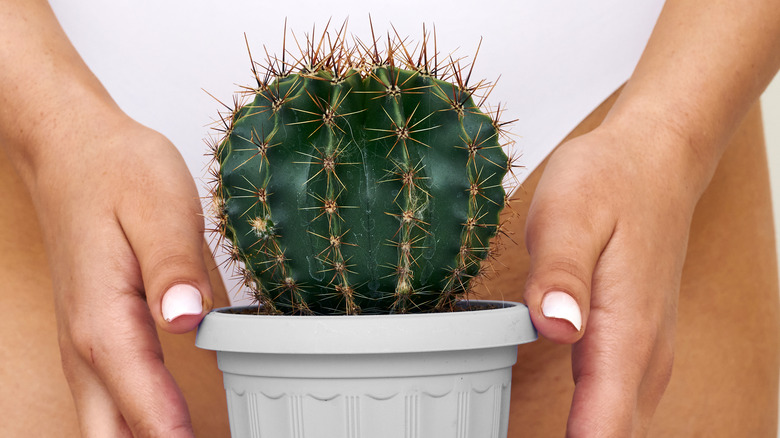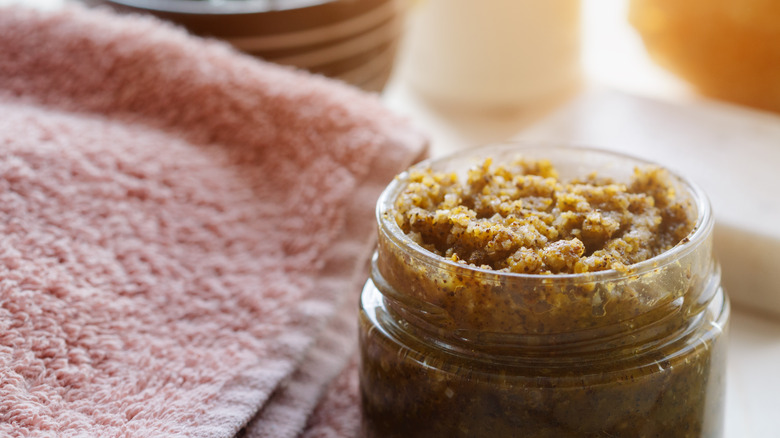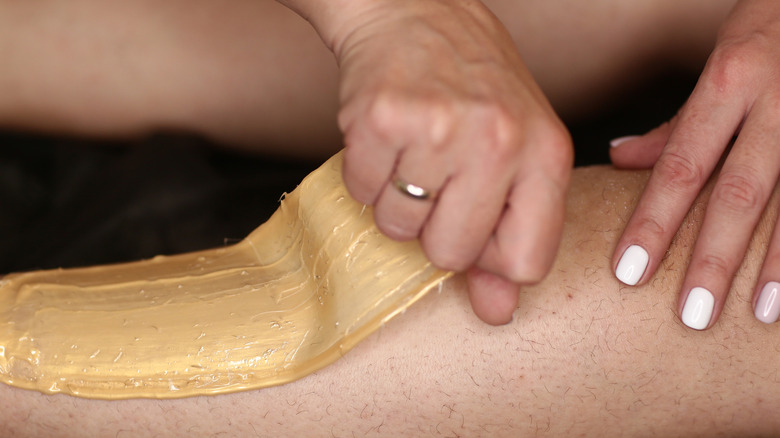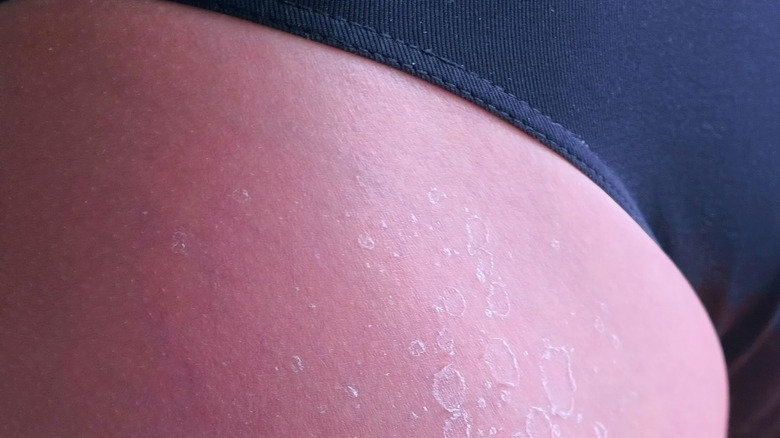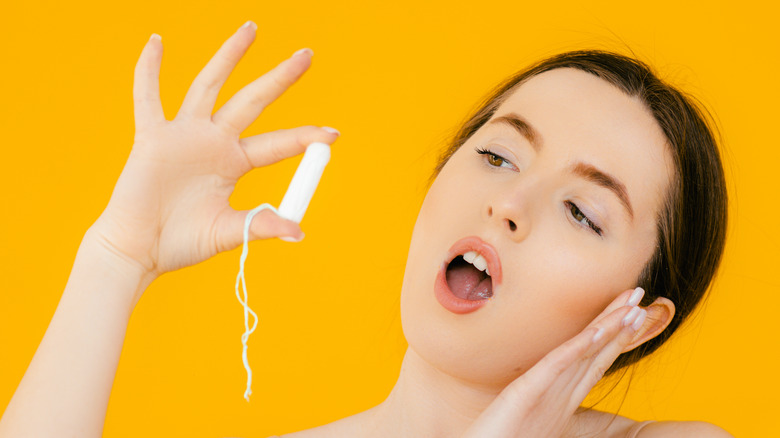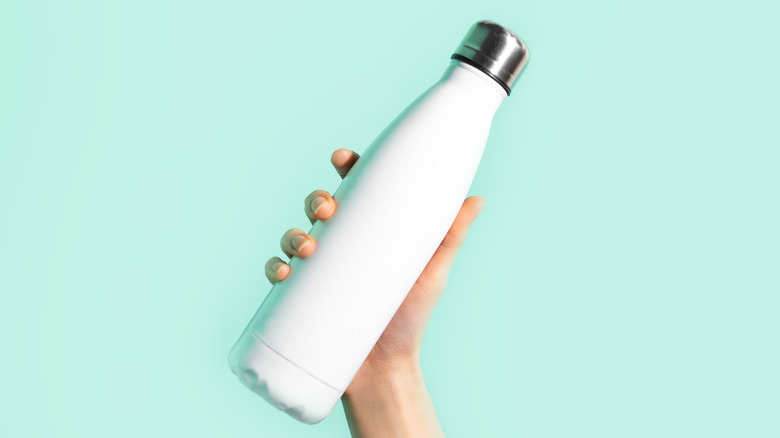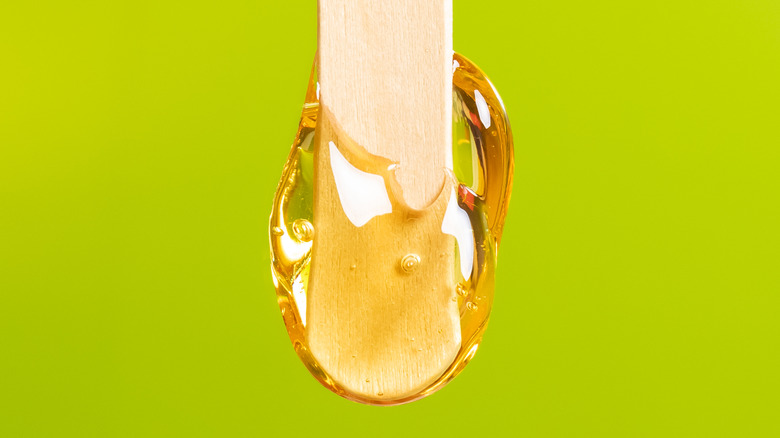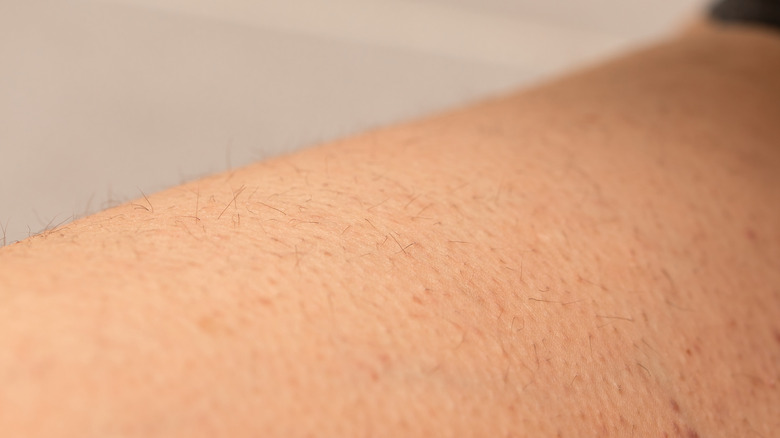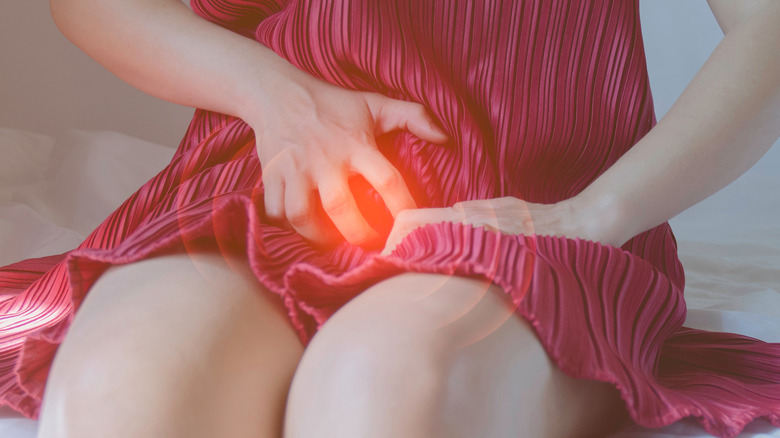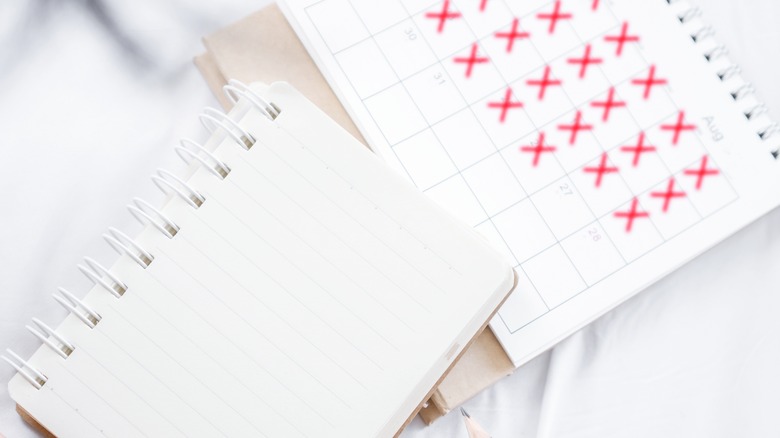Everything You Should Know Before Getting A Brazilian Wax
Brazilian waxes: You've seen them talked about on TV, you may know someone who's gotten one, and there's a chance you've even considered getting one yourself. But how much do you really know about this (literally) below the belt beauty treatment?
It should go without saying that how you manicure your pubic hair is a matter of personal taste, but it's hard to argue against the fact that trimming, or for that matter, completely eliminating pubic hair has grown in popularity over recent years. Vanity Fair points out that the Brazilian wax actually got its name from a group of Brazilian sisters who came to the United States and popularized the style of waxing in the early 90's. Officially, the Cleveland Clinic defines the Brazilian wax as a wax that removes "all or most pubic hair." This means getting rid of the hair that grows along the edge of the thigh, below the navel, and of course, the hair around the genitals.
Some of the benefits of getting a Brazilian wax include the potential for less irritation compared to other hair removal methods, long lasting results, and less hair in the long run. If you're considering getting a Brazilian wax and want to learn more, continue reading.
It's going to hurt
Yep. There's really no two ways around this one. Although of course, pain tolerance will vary from person to person, it's safe to say that there will be at least some level of pain associated with getting a Brazilian.
Dr. Loretta Ciraldo, FAAD, a dermatologist based in Miami and founder of the Dr. Loretta skincare brand, spoke to Byrdie Beauty to further explain the pain that comes with waxing. "There is a lot of pain associated with this procedure...Anatomically, the hair root close to the nerve root," she explains. She also explains that our nether regions are generally more sensitive than other areas of the body, which makes getting a Brazilian more painful. "Patients tell me that the most painful areas for waxing are also the most overall sensitive areas, especially in the pubic area. This area has a higher concentration of sensory nerves, so it will generally be more painful to wax than, for instance, the underarms," she went on to say.
To help lessen pain during treatments, Ciraldo suggests applying a hydrocortisone cream to your bikini area at least an hour before you get waxed to help reduce inflammation. You can also apply a numbing product such as lidocaine to your bikini area, as well as take acetaminophen a half an hour before your treatment to alleviate pain.
Make sure you find the right esthetician
To make your Brazilian wax as "smooth" as possible (pun intended), finding the right esthetician is key. Dermatologist Shilpi Khetarpal, MD, spoke to the Cleveland Clinic and explained, "Hair removal does have a risk of infection or injury if it's not done correctly. Read reviews and ask for recommendations to find a trustworthy salon."
In order for an esthetician to be able to provide a Brazilian wax, a license will be required in most cases. Furthermore, it's important to make sure your esthetician is wearing gloves, and doesn't do what the clinic calls "double dipping." This means they do not dip the same stick they used on one area into the wax again to use on another area. Instead, they should be using a new stick each time.
Gina Petak, licensed aesthetician and education manager for European Wax Center spoke to Allure and backed up this sentiment. She also defines double dipping as using the same wax sticks between clients, which is obviously a huge no-no. "Double-dipping is highly unsanitary and can cause the spreading of bacteria and infections between guests," she said. Other things to consider include ensuring that the paper on the waxing table is cleaned between each client, and that the environment in general is in tip-top shape.
Your hair has to be a certain length
If you're the type that likes to keep your area tidy, clean and perfectly trimmed at all times, you may have a hard time with this one. According to beauty experts at Allure, in order to get a proper Brazilian wax, your pubic hair needs to be "at least a quarter inch long," or in other words, the "size of a sprinkle." This means that whatever hair removal methods you're using to tidy up are going to have to be put on hold at least five days before you go in to get waxed.
Healthline explains that hair needs to be at least a ¼ of an inch, because the wax needs to be able to properly stick to the hair for it to be pulled out at the root. If it's too short, the wax may not pull it from the root, and it may just end up breaking off.
Experts at the Cleveland Clinic suggest limiting hair growth to a maximum of ¾ of an inch long before waxing, as anything longer would make it difficult to wax. However, Allure experts think differently. Gina Petak, who previously spoke to the site about double-dipping, says not to worry, as "your hair can never be too long to come see [them]." She also emphasized that their wax specialists receive the proper training "to work with all hair and skin types."
You should exfoliate beforehand
In addition to making sure your hair is the right length before waxing, part of your pre-wax routine should include exfoliating, according to experts.
While exfoliating is a good idea any time, doing so before waxing can significantly improve the results of your treatment. One of the reasons for doing so include the prevention of ingrown hairs, per the Cleveland Clinic. Healthline further explains that exfoliating at least two or three days before getting waxed with a "mild scrub, brush, mitt, or loofah" will help get rid of dead skin cells around the hair follicles. If you already have ingrown hairs, exfoliating will help loosen them, and may prevent them from occurring after waxing.
While you may be tempted to go to town, it's a good idea to be gentle to avoid any potential irritation, which could make the waxing process more painful. Furthermore, experts at the Bella Sante Day Spa suggest avoiding harsh exfoliation the day of your appointment, and to use a gentle washcloth instead.
You can choose between hard and soft wax
One positive side effect of waxing growing in popularity is the fact that there are now a variety of techniques designed to make the process easier. Healthline explains that when it comes to waxing, there are two options available: hard and soft. Hard wax may be your best bet when waxing sensitive areas such as the bikini line. New York City-based dermatologist Dr. Hadley King spoke to the site and said, "Since hard wax only sticks to the hair, you can treat and retreat areas to make sure all of the hairs are removed without damaging the skin."
When compared to soft wax, hard wax is thicker, and hardens on the skin. For this reason, you don't need to apply a strip to the wax to pull it off; you can pull it off with your hand, which makes the process less painful. It also leaves behind less residue than soft wax. Soft wax, on the other hand, adheres directly to the skin. This means that in addition to the hair being pulled off, the top layer of your skin is pulled off as well. The plus side of soft wax is that it can be applied to a larger area of skin (which doesn't apply in the case of a Brazilian), and that it may be more affordable than hard wax.
Don't go if you're sunburnt
If you were thinking about basking (or baking) in the sun or a tanning bed before you head to your Brazilian wax, you might want to think twice. While it might not be super common to go spread eagle in the sun or a tanning bed before your treatment...you never know, and if you do, you can't say we didn't warn you.
As Cosmopolitan explains, basking in the sun pre-Brazilian wax is a huge no-no. Gina Petak, Education Manager at European Wax Center, put it quite bluntly: "We can't wax sunburned skin," because high levels of sun exposure make your skin very sensitive and vulnerable to peeling after a wax. To be safe, she suggests staying out of the sun at least a week before your treatment, and making sure to apply SPF to all areas.
Waxing experts at Cirepil by Perron Rigot say that waxing sunburnt skin can even lead to hyperpigmentation. Furthermore, they suggest staying out of the sun after your wax as well, as waxing can be considered a mild exfoliation, making skin thinner and more vulnerable to sun damage. If you're going to vacation in a sunny spot, be sure to get waxed at least two to three days before you head out — and of course, apply SPF.
You can get waxed on your period, but it may hurt more
If you planned your waxing appointment and at the same time received an unplanned visit from your monthly cycle the same day, don't worry: you don't have to cancel the wax.
Experts at Shape say that it is a-okay to get a Brazilian wax while you're on your period, but there are some precautions and considerations to bear in mind. Deidra Green, a licensed and certified esthetician and a field training manager at European Wax Center, explains that as long as your skin is healthy and you are wearing either a tampon or a menstrual cup, you should be good to go. She suggests avoiding wearing a menstrual pad to the appointment for sanitary purposes, and says that "although [their] cleaners are strong enough to kill bloodborne pathogens, it is safer to use a tampon or menstrual cup to reduce any exposure."
On the other hand, she does mention that during menstruation, our bodies are typically more sensitive to pain as a result of hormone fluctuations, which may also lead to bruising. "Most estheticians would recommend that you wait if you can, just so the experience is more comfortable for you. However, we understand that not everyone has a regular period, so it can be unavoidable."
Before heading to your appointment, be sure to "freshen up" — and make sure your tampon string is out of the way so the esthetician can properly wax.
Make sure your skin is hydrated
It's common knowledge that drinking water is a necessity for your skin, hair, and pretty much every other function in your body. Before getting waxed, it's even more important to pay attention to your water consumption to make sure your skin and hair are in tip top shape for the procedure.
Gina Petak, Education Manager at European Wax Center spoke to Cosmopolitan, explaining that dry skin typically means dry hair — which in turn means that no matter how skilled your specialist is, waxing will probably break your hair. Before you get waxed, she suggests drinking at least eight glasses of water every day approaching your appointment.
In case you are a water skeptic, Healthline's experts confirm that drinking water does in fact have a positive effect on your hydration levels. The site explains that our skin is made up of 30% water, and drinking enough of it can help prevent water loss, and thus help us maintain proper skin hydration. Andrea Weber, the head of research and development for skin care line BABOR, spoke to the site and said regarding drinking water, "It is as easy as that. The more moisture we give to our body from the inside, the better our protective barrier works."
Don't try it at home
If you find yourself in a pinch and need to get rid of some stray hairs stat, the experts suggest avoiding going it alone, and going to them instead.
While it may be tempting to wax at home — whether it's for time concerns, convenience, or just the thrill of taking matters into your own hands — there are several reasons why visiting a salon is your best bet. Chapel Hill, North Carolina-based, board-certified dermatologist Chris G. Adigun spoke to Allure and explained why doing it solo is a no-go. "Unless you are an experienced at-home waxer, I am always very cautious to recommend it. There are many variables that can go awry with waxing at home, including managing the temperature of the wax, which requires heating, waxing off just the hair (and not the skin), and irritated reactions to components of the kits."
A few of the things that can go wrong with an at home wax include ingrown hairs, burns, infections, and rashes, according to Adigun. Experts at Healthline reiterate concerns about at-home waxing, and say that waxing the bikini line in particular is something that should absolutely be left to the professionals.
You might experience bumps afterwards
One potentially unpleasant side effect of waxing for smooth skin is bumps. The good news: According to Healthline, these bumps are actually quite normal and usually clear up in a few days.
The technical name for these bumps is called folliculitis, which generally means a bumpy rash that may look like pimples. Folliculitis can be the result of a couple things, so it's important to assess the source before treating it. For example, bumps that are white in color and filled with fluid may be a result of an infection, and they typically last a few days. These can be treated at home with a number of remedies. The other type of folliculitis can appear as a result of ingrown hairs, and this will typically develop after the initial inflammation from waxing goes down. Ingrown hairs happen when hair grows back into the skin instead of outwards. They are more common in people with coarse or curly hair, and can also be treated at home.
To treat these, you can use a warm compress to help "draw out" the hair, which could include a warm washcloth or a heating pad. To treat folliculitis caused by infection, you can apply diluted tea tree oil to the area a couple days after your treatment. You may also apply aloe vera, witch hazel, or apple cider vinegar, or use a homemade sugar scrub a couple days afterwards.
You might be sore afterwards
This one may not come as a surprise, considering you already know that waxing is going to hurt. Per Skincare, those with sensitive skin may feel the after effects more than most, but there are a bevy of remedies and techniques you can use to soothe irritation.
For starters, avoid using chemical or physical exfoliants directly after waxing, or until sensitivity subsides. Take a lukewarm shower (avoid hot steamy ones), and be sure to use a creamy and nourishing cleanser to clean the affected area. Be sure to avoid touching the area with dirty hands, as your pores are more open after treatment and can be more susceptible to infection. If you want to soothe the area, you can wash your hands and apply a cold compress. You can also apply a hydrocortisone cream to help soothe any inflammation.
It may take some time for your redness to subside. However, if it doesn't go down within a couple weeks, it might be best to take a visit to your dermatologist. Things you can do to help prevent soreness after waxing include finding a gentler wax that is more suited to sensitive skin, applying baby powder pre-waxing, and not using wax that is too hot.
The results could last anywhere from three to six weeks
One of the good things about waxing when compared to other hair removal techniques is that the results last significantly longer than most.
Experts at Healthline estimate that you'll start to see new hair growing in about two weeks after your treatment. Despite this, you'll need an additional two to three weeks of hair growth before your hair is long enough to get waxed again. That is to say, if you're not a fan of letting your hair grow out, getting a Brazilian might not be your go-to option for hair removal.
Believe it or not, how fast your hair grows back can be influenced by both internal and external factors. Internal factors include hormones and genetics, while external factors include the type of food you consume. If you're eating foods that are rich in fish and certain vitamins, you can expect your hair to grow back at a faster rate. If you're stressed about the idea of having to wait between waxes, one side effect of getting waxed regularly is that your hair actually grows back thinner over time. Natalie Laine, a licensed esthetician and the owner of Skin Care By Natalie in Willoughby, OH, spoke to Healthline and said, "This ends up happening because of the damage the hair follicle experiences by pulling out the entire hair, including the bulb, from the hair follicle through seven layers of skin."
Avoid friction and irritation afterwards
As you know by now, after getting waxed, your skin is going to be sensitive and in need of some TLC and a little down time. Avoiding certain irritants can help prevent you from getting, well, irritated, and make the recovery process smoother.
For example, regarding exercising, Angelea Mason, owner and waxing specialist at Brazilia Waxing Spa, spoke to Women's Running and explained that waiting at least a day after getting waxed to start running is a good idea. "After receiving your waxing service we recommend no exercising until the following day," she said. She also advises avoiding "any public water areas, such as hot tubs, saunas, pools and spas, while the skin is healing to prevent infections and avoid tight clothing if the bikini area was waxed."
Rena Rubin, wax expert and esthetician at Haven Spa in Manhattan, NY, confirms the guidance on wearing loose fitting garments (via Hello Giggles). "Tight-fitting garments don't allow the skin to breathe or to heal after waxing," she explains. Clothing such as maxi dresses, skirts, and loose pants are much more favorable. Furthermore, Rubin states that having sex directly afterwards is also a no-go. She suggests waiting at least 24 hours after waxing to have intercourse.

